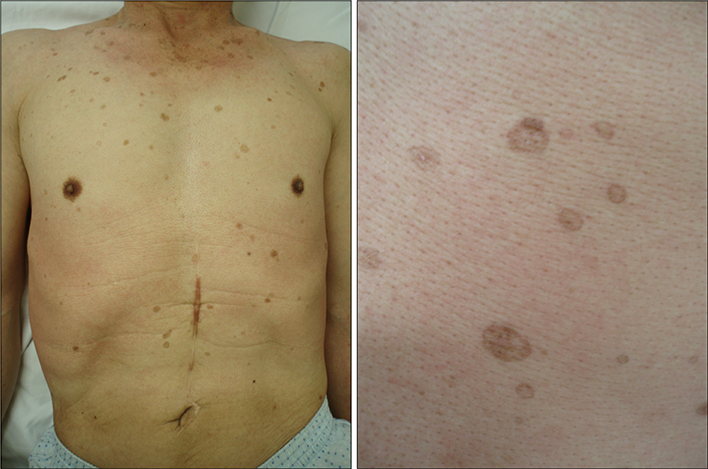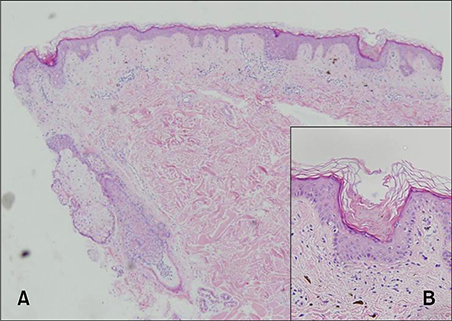Ann Dermatol.
2008 Dec;20(4):193-196. 10.5021/ad.2008.20.4.193.
Disseminated Superficial Porokeratosisin a Patient with Gastric Cancer
- Affiliations
-
- 1Department of Dermatology, Seoul National University College of Medicine, Seoul, Korea.
- 2Department of Dermatology, Boramae Medical Center, Seoul, Korea. sycho@snu.ac.kr
- KMID: 2156392
- DOI: http://doi.org/10.5021/ad.2008.20.4.193
Abstract
- Disseminated superficial porokeratosis (DSP) is a rare variant of porokeratosis, which is characterized histologically by cornoid lamella and clinically by central atrophy with elevated borders. DSP is usually associated with immunosuppressive states and hematopoietic malignancies, but rarely with malignancies of visceral organs. A 65-year-old male presented with numerous brownish macules with elevated borders on the trunk and limbs that had been present for 1 year. Before the visit to our clinic, gastric cancer was diagnosed at about the same time the skin lesions suddenly increased in size and number. Clinical and histopathological examination revealed that the lesions were consistent with DSP. We herein report a rare case of disseminated superficial porokeratosis that occurred in association with gastric cancer.
Figure
Reference
-
1. Kanitakis J, Euvrard S, Faure M, Claudy A. Porokeratosis and immunosuppression. Eur J Dermatol. 1998; 8:459–465.2. Knoell KA, Patterson JW, Wilson BB. Sudden onset of disseminated porokeratosis of Mibelli in a renal transplant patient. J Am Acad Dermatol. 1999; 41:830–832.
Article3. Kanitakis J, Euvrard S, Claudy A. Porokeratosis in organ transplant recipients. J Am Acad Dermatol. 2001; 44:144–146.
Article4. Rio B, Magana C, Le Tourneau A, Bachmeyer C, Levy V, Hamont N, et al. Disseminated superficial porokeratosis after autologous bone marrow transplantation. Bone Marrow Transplant. 1997; 19:77–79.
Article5. Hunt SJ, Sharra WG, Abell E. Linear and punctate porokeratosis associated with end-stage liver disease. J Am Acad Dermatol. 1991; 25:937–939.
Article6. Hernandez MH, Lai CH, Mallory SB. Disseminated porokeratosis associated with chronic renal failure: a new type of disseminated porokeratosis? Arch Dermatol. 2000; 136:1568–1569.
Article7. Rodriguez EA, Jakubowicz S, Chinchilla DA, Carril A, Viglioglia PA. Porokeratosis of Mibelli and HIV-infection. Int J Dermatol. 1996; 35:402–404.
Article8. Lee HW, Oh SH, Choi JC, Chang SE, Lee MW, Choi JH, et al. Disseminated superficial porokeratosis in a patient with cholangiocarcinoma. J Am Acad Dermatol. 2006; 54(2 Suppl):S56–S58.
Article9. Takata M, Shirasaki F, Nakatani T, Takehara K. Hereditary non-polyposis colorectal cancer associated with disseminated superficial porokeratosis. Microsatellite instability in skin tumours. Br J Dermatol. 2000; 143:851–855.
Article10. Lee HJ, Yang HK, Ahn YO. Gastric cancer in Korea. Gastric Cancer. 2002; 5:177–182.
Article11. Takashi M, Choitsu S, Toshiya S, Kohei M, Tohru U, Osamu N, et al. p53 gene mutations in human gastric cancer: wild-type p53 but not mutant p53 suppresses growth of human gastric cancer cells. Cancer Res. 1992; 52:4335–4341.12. Gunther T, Schneider-Stock R, Hackel C, Kasper HU, Pross M, Hackelsberger A, et al. Mdm2 gene amplification in gastric cancer correlation with expression of Mdm2 protein and p53 alterations. Mod Pathol. 2000; 13:621–626.
Article13. Nelson C, Cowper S, Morgan M. p53, mdm-2, and p21 waf-1 in the porokeratoses. Am J Dermatopathol. 1999; 21:420–425.
Article14. Shumack S, Commens C, Kossard S. Disseminated superficial actinic porokeratosis. A histological review of 61 cases with particular reference to lymphocytic inflammation. Am J Dermatopathol. 1991; 13:26–31.15. Tahara E. Growth factors and oncogenes in human gastrointestinal carcinomas. J Cancer Res Clin Oncol. 1990; 116:121–131.
Article16. Yonemura Y, Takamura H, Ninomiya I, Fushida S, Tsugawa K, Kaji M, et al. Interrelationship between transforming growth factor-alpha and epidermal growth factor receptor in advanced gastric cancer. Oncology. 1992; 49:157–161.
Article17. Yamaoka Y, Kodama T, Kita M, Imanishi J, Kashima K, Graham DY. Relation between cytokines and Helicobacter pylori in gastric cancer. Helicobacter. 2001; 6:116–124.
Article18. Yasumoto K, Okamoto S, Mukaida N, Murakami S, Mai M, Matsushima K. Tumor necrosis factor alpha and interferon gamma synergistically induce interleukin 8 production in a human gastric cancer cell line through acting concurrently on AP-1 and NF-kB-like binding sites of the interleukin 8 gene. J Biol Chem. 1992; 267:22506–22511.
Article
- Full Text Links
- Actions
-
Cited
- CITED
-
- Close
- Share
- Similar articles
-
- Exacerbation of Disseminated Superficial Actinic Porokeratosis in a Patient with Colon Cancer
- Inflammatory Disseminated Superficial Porokeratosis Successfully Managed by Oral Isotretinoin
- A Case of Squamous Cell Carcinoma and Bowen's Disease Associated with Superficial Disseminated Porokeratosis
- Inflammatory Disseminated Superficial Porokeratosis
- Advanced Gastric Cancer Associated with Disseminated Intravascular Coagulation Successfully Treated with 5-fluorouracil and Oxaliplatin



